

Compact Muon Solenoid
LHC, CERN
| CMS-PAS-SUS-18-002 | ||
| Search for supersymmetry in events with a photon, jets, and missing transverse momentum in proton-proton collisions at 13 TeV | ||
| CMS Collaboration | ||
| September 2018 | ||
| Abstract: A search for supersymmetry is presented based on events with at least one photon, multiple jets, and large missing transverse momentum produced in proton-proton collisions at a center-of-mass energy of √s= 13 TeV. The data correspond to an integrated luminosity of 35.9 fb−1 and were recorded by the CMS detector in 2016 at the LHC. The analysis characterizes signal-like events by categorizing the data into various signal regions based on the number of jets, the number of b-tagged jets, and missing transverse momentum. No significant excess of events is observed with respect to expectations from standard model processes. Limits are placed on gluino, top squark, and neutralino masses using several simplified models of pair production of supersymmetric particles with gauge-mediated supersymmetry breaking. Depending on the model and the mass of the next-to-lightest supersymmetric particle, gluino masses as large as 2120 GeV and top squark masses as large as 1230 GeV are excluded. | ||
|
Links:
CDS record (PDF) ;
CADI line (restricted) ;
These preliminary results are superseded in this paper, EPJC 79 (2019) 444. The superseded preliminary plots can be found here. |
||
| Figures | |

png pdf |
Figure 1:
Example Feynman diagrams depicting the simplified models used. The top left diagram depicts the T5qqqqHG model, the top right diagram depicts the T5bbbbZG model, the bottom left diagram depicts the T5ttttZG model, and the bottom right depicts the T6ttZG model. |
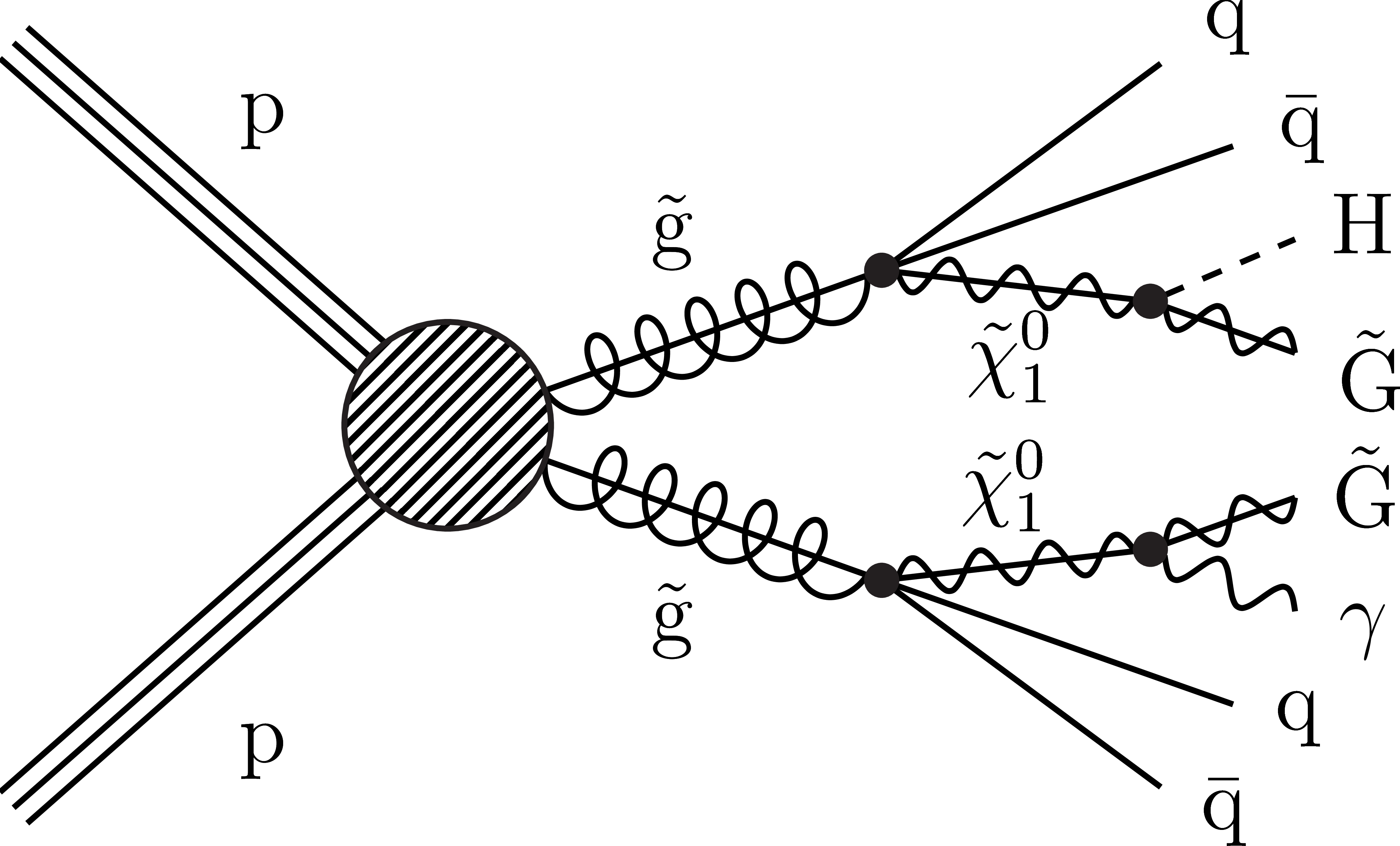
png pdf |
Figure 1-a:
Example Feynman diagrams depicting the simplified models used. The top left diagram depicts the T5qqqqHG model, the top right diagram depicts the T5bbbbZG model, the bottom left diagram depicts the T5ttttZG model, and the bottom right depicts the T6ttZG model. |

png pdf |
Figure 1-b:
Example Feynman diagrams depicting the simplified models used. The top left diagram depicts the T5qqqqHG model, the top right diagram depicts the T5bbbbZG model, the bottom left diagram depicts the T5ttttZG model, and the bottom right depicts the T6ttZG model. |
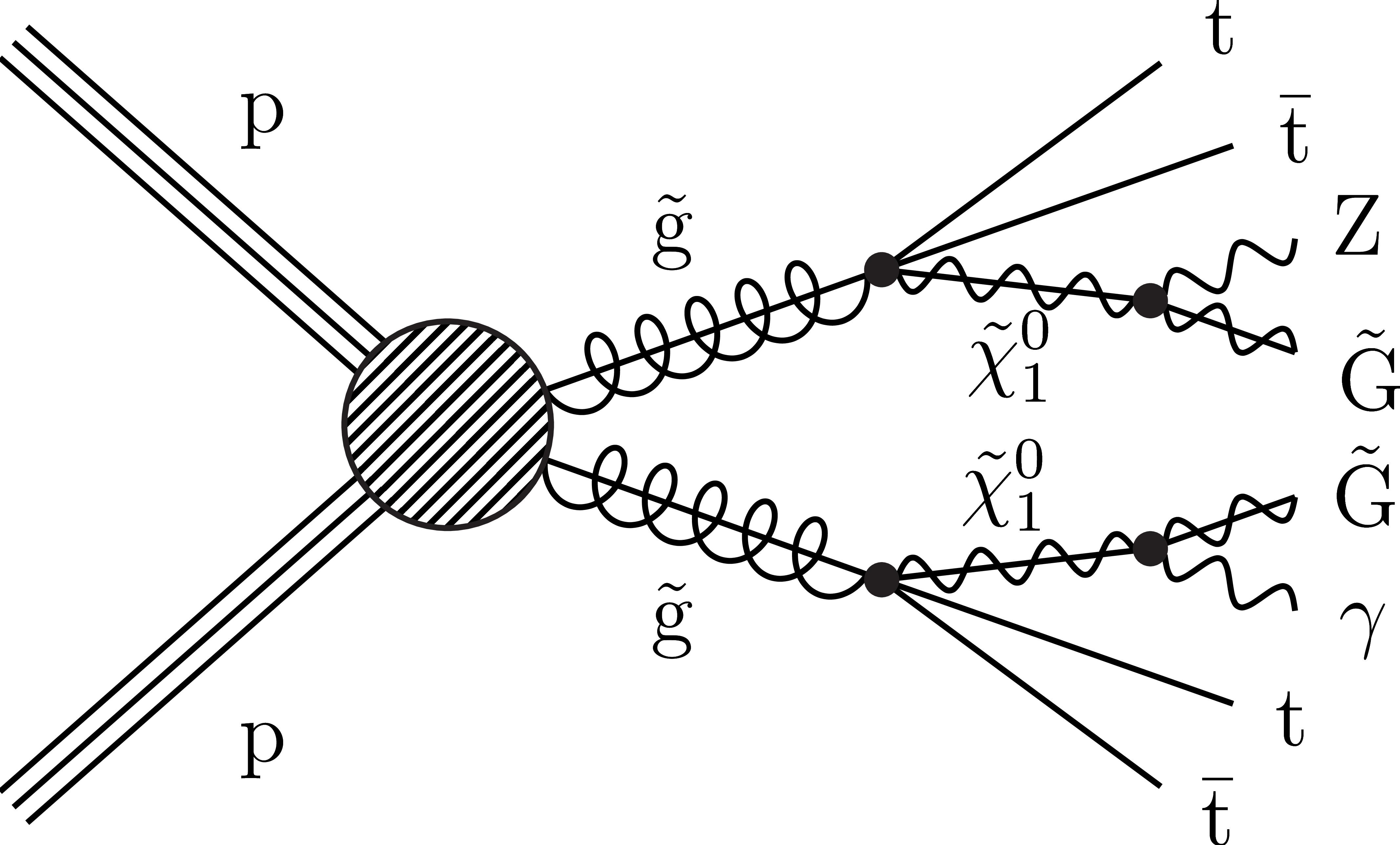
png pdf |
Figure 1-c:
Example Feynman diagrams depicting the simplified models used. The top left diagram depicts the T5qqqqHG model, the top right diagram depicts the T5bbbbZG model, the bottom left diagram depicts the T5ttttZG model, and the bottom right depicts the T6ttZG model. |
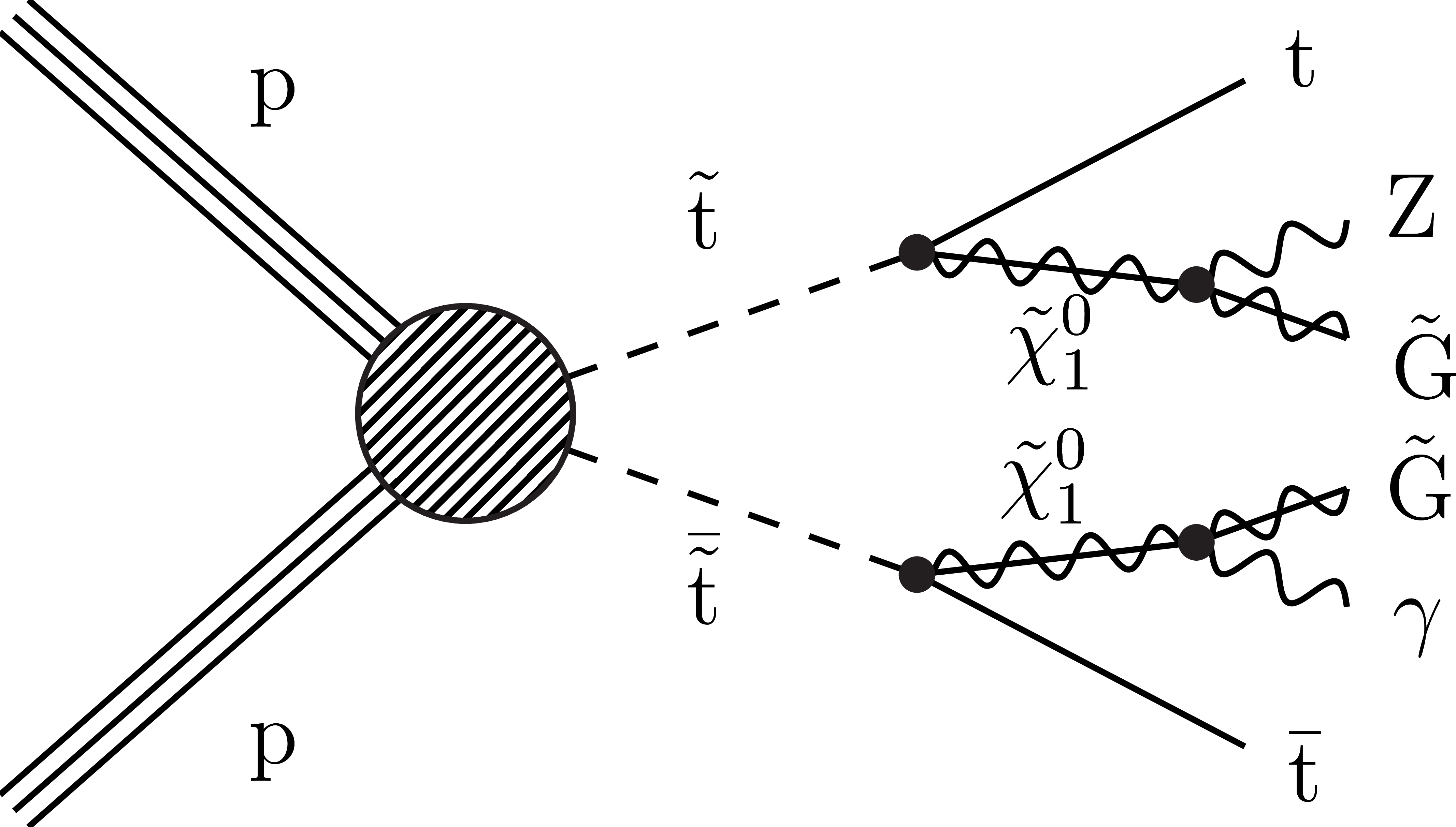
png pdf |
Figure 1-d:
Example Feynman diagrams depicting the simplified models used. The top left diagram depicts the T5qqqqHG model, the top right diagram depicts the T5bbbbZG model, the bottom left diagram depicts the T5ttttZG model, and the bottom right depicts the T6ttZG model. |

png pdf |
Figure 2:
The lost-lepton and τhad event yields as predicted directly from simulation in the signal regions, shown in red, and from the prediction procedure applied to simulated eγ or μγ events, shown in blue. The error bars correspond to the statistical uncertainties from the limited number of events in simulation. The bottom panel shows the ratio of the simulation expectation (Exp.) and the simulation-based prediction (Pred.). The hashed area shows the expected uncertainties from parton distribution functions, renormalization and factorization scale uncertainties, and data-to-simulation correction factor uncertainties. The categories, denoted by dashed lines, are labeled as Nbj, where j refers to the number of jets and b refers to the number of b-tagged jets. The numbered bins within each category are the various pTmiss bins. In each of these regions, the first bin corresponds to 100 <pTmiss< 200 GeV, which is used for SM predictions. Note that the kinematic variable requirements used to derive the average transfer factors are different from those used to define the search regions. Expectations and predictions are compatible within uncertainties. |

png pdf |
Figure 3:
Validation of the double ratio κ in each Njets−Nb-jets region for zero photon events. The black points are the observed κ values after subtracting the electroweak contamination based on the simulation. The blue points are the κ values computed directly from the simulation. The ratio is shown in the bottom panel, where the hashed region corresponds to the systematic uncertainty in the γ+jets prediction. In the label Nbj, j refers to the number of jets and b refers to the number of b-tagged jets. |

png pdf |
Figure 4:
Distribution of predicted SM background events from various sources and observed events in each of the 25 signal regions. The categories, denoted by dashed lines, are labeled as Nbj, where j refers to the number of jets and b refers to the number of b-tagged jets. The numbered bins within each category are the various pTmiss bins. The lower pane shows the ratio of observed events to predicted SM background events. The error bars in the lower pane are the quadrature sum of the statistical uncertainty in the observed data and the systematic uncertainty in the predicted backgrounds before adjustments based on a maximum likelihood fit to data assuming a signal strength of zero. The observed event yields are consistent with the predicted SM backgrounds within one standard deviation in all bins except bin 2, as discussed in the text. |

png pdf |
Figure 5:
Observed and expected 95% CL upper limits for gluino or top squark pair production cross sections for the (upper left) T5qqqqHG, (upper right) T5bbbbZG, (bottom left) T5ttttZG, and (bottom right) T6ttZG models. Black lines denote the observed exclusion limit and the uncertainty due to variations of the theoretical prediction of the gluino or top squark pair production cross section. The dashed lines correspond to the region containing 68% of the distribution of the expected exclusion limits under the background-only hypothesis. |

png pdf |
Figure 5-a:
Observed and expected 95% CL upper limits for gluino or top squark pair production cross sections for the (upper left) T5qqqqHG, (upper right) T5bbbbZG, (bottom left) T5ttttZG, and (bottom right) T6ttZG models. Black lines denote the observed exclusion limit and the uncertainty due to variations of the theoretical prediction of the gluino or top squark pair production cross section. The dashed lines correspond to the region containing 68% of the distribution of the expected exclusion limits under the background-only hypothesis. |
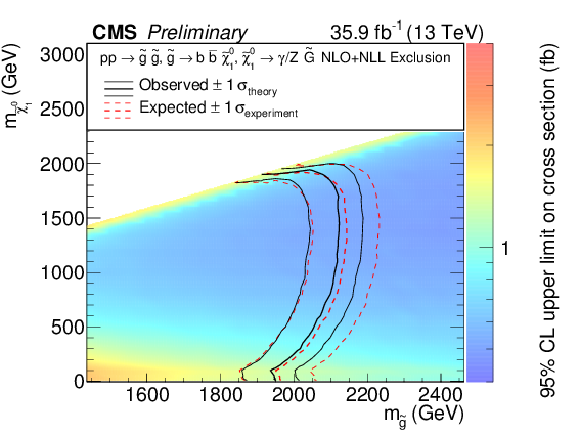
png pdf |
Figure 5-b:
Observed and expected 95% CL upper limits for gluino or top squark pair production cross sections for the (upper left) T5qqqqHG, (upper right) T5bbbbZG, (bottom left) T5ttttZG, and (bottom right) T6ttZG models. Black lines denote the observed exclusion limit and the uncertainty due to variations of the theoretical prediction of the gluino or top squark pair production cross section. The dashed lines correspond to the region containing 68% of the distribution of the expected exclusion limits under the background-only hypothesis. |
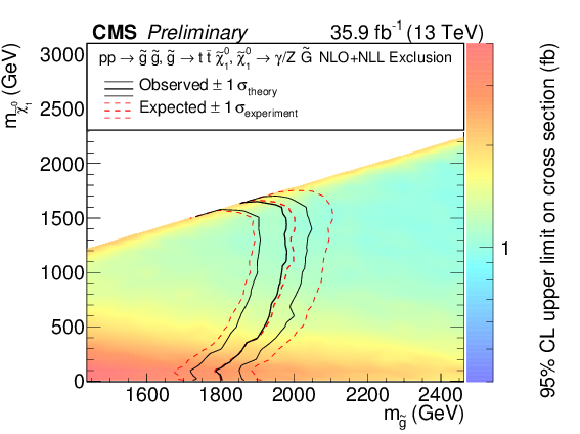
png pdf |
Figure 5-c:
Observed and expected 95% CL upper limits for gluino or top squark pair production cross sections for the (upper left) T5qqqqHG, (upper right) T5bbbbZG, (bottom left) T5ttttZG, and (bottom right) T6ttZG models. Black lines denote the observed exclusion limit and the uncertainty due to variations of the theoretical prediction of the gluino or top squark pair production cross section. The dashed lines correspond to the region containing 68% of the distribution of the expected exclusion limits under the background-only hypothesis. |

png pdf |
Figure 5-d:
Observed and expected 95% CL upper limits for gluino or top squark pair production cross sections for the (upper left) T5qqqqHG, (upper right) T5bbbbZG, (bottom left) T5ttttZG, and (bottom right) T6ttZG models. Black lines denote the observed exclusion limit and the uncertainty due to variations of the theoretical prediction of the gluino or top squark pair production cross section. The dashed lines correspond to the region containing 68% of the distribution of the expected exclusion limits under the background-only hypothesis. |
| Tables | |

png pdf |
Table 1:
Predicted and observed event yields for each signal region. |
| Summary |
|
A search for gluino and top squark pair production is presented, based on proton-proton collisions dataset with a center-of-mass energy of 13 TeV recorded in 2016 with the CMS detector. The data correspond to an integrated luminosity of 35.9 fb−1. Events are required to have at least one isolated photon with pT> 100 GeV, two jets with pT> 30 GeV and |η|<2.4, and large missing transverse momentum pmissT> 200 GeV. The data are categorized into 25 independent signal regions based on the number of jets, the number of b-tagged jets, and pmissT. Background yields from standard model processes are predicted using simulation and data control regions. The observed event yields are found to be consistent with expectations from the SM processes within uncertainties. Results are interpreted in the context of simplified models. Four such models are studied, three of which involve gluino pair production and one of which involves top squark pair production. All models assume a gauge-mediated supersymmetry breaking scenario, in which the lightest supersymmetric particle is a gravitino. We consider scenarios in which the gluino decays to a neutralino ˜χ01 and a pair of light-flavor quarks (T5qqqqHG), bottom quarks (T5bbbbZG), or top quarks (T5ttttZG). In the T5qqqqHG model, the ˜χ01 decays either to a photon and gravitino ˜G or to a Higgs boson and ˜G, with branching fraction 50%. In the T5bbbbZG and T5ttttZG models, the ˜χ01 decays either to a photon and ˜G or to a Z boson and ˜G, with branching fraction 50%. In the top squark pair production model (T6ttZG), top squarks decay to a top quark and ˜χ01, and the ˜χ01 decays to a photon and ˜G or to a Z boson and ˜G with a branching fraction of 50%. Using the next-to-leading-order plus next-to-leading-logarithmic cross sections for supersymmetric pair production, we place 95% confidence level upper limits on the gluino mass as large as 2120 GeV, depending on the model and m˜χ01, and limits on the top squark mass as large as 1230 GeV, depending on m˜χ01. These results improve upon those from previous searches for supersymmetry with photons [26,27]. |
| References | ||||
| 1 | F. Zwicky | Die rotverschiebung von extragalaktischen nebeln | Helv. Phys. Acta 6 (1933)110 | |
| 2 | V. C. Rubin and W. K. Ford Jr | Rotation of the Andromeda nebula from a spectroscopic survey of emission regions | Astrophys. J. 159 (1970) 379 | |
| 3 | R. Barbieri and G. F. Giudice | Upper bounds on supersymmetric particle masses | NPB 306 (1988) 63 | |
| 4 | S. Dimopoulos and G. F. Giudice | Naturalness constraints in supersymmetric theories with nonuniversal soft terms | PLB 357 (1995) 573 | hep-ph/9507282 |
| 5 | R. Barbieri and D. Pappadopulo | S-particles at their naturalness limits | JHEP 10 (2009) 061 | 0906.4546 |
| 6 | M. Papucci, J. T. Ruderman, and A. Weiler | Natural SUSY endures | JHEP 09 (2012) 035 | 1110.6926 |
| 7 | CMS Collaboration | Measurements of properties of the Higgs boson decaying into the four-lepton final state in pp collisions at √s= 13 TeV | JHEP 11 (2017) 047 | CMS-HIG-16-041 1706.09936 |
| 8 | ATLAS and CMS Collaborations | Combined measurement of the Higgs boson mass in pp collisions at √s= 7 and 8 TeV with the ATLAS and CMS experiments | PRL 114 (2015) 191803 | 1503.07589 |
| 9 | P. Ramond | Dual theory for free fermions | PRD 3 (1971) 2415 | |
| 10 | Y. A. Gol'fand and E. P. Likhtman | Extension of the algebra of Poincar\'e group generators and violation of P invariance | JEPTL 13 (1971)323 | |
| 11 | A. Neveu and J. H. Schwarz | Factorizable dual model of pions | NPB 31 (1971) 86 | |
| 12 | D. V. Volkov and V. P. Akulov | Possible universal neutrino interaction | JEPTL 16 (1972)438 | |
| 13 | J. Wess and B. Zumino | A lagrangian model invariant under supergauge transformations | PLB 49 (1974) 52 | |
| 14 | J. Wess and B. Zumino | Supergauge transformations in four dimensions | NPB 70 (1974) 39 | |
| 15 | P. Fayet | Supergauge invariant extension of the Higgs mechanism and a model for the electron and its neutrino | NPB 90 (1975) 104 | |
| 16 | H. P. Nilles | Supersymmetry, supergravity and particle physics | Phys. Rep. 110 (1984) 1 | |
| 17 | G. R. Farrar and P. Fayet | Phenomenology of the production, decay, and detection of new hadronic states associated with supersymmetry | PLB 76 (1978) 575 | |
| 18 | P. Meade, N. Seiberg, and D. Shih | General gauge mediation | Prog. Theor. Phys. Suppl. 177 (2009) 143 | 0801.3278 |
| 19 | S. Deser and B. Zumino | Broken supersymmetry and supergravity | PRL 38 (1977) 1433 | |
| 20 | E. Cremmer et al. | Super-higgs effect in supergravity with general scalar interactions | PLB 79 (1978) 231 | |
| 21 | N. Arkani-Hamed et al. | MARMOSET: The path from LHC data to the new standard model via on-shell effective theories | hep-ph/0703088 | |
| 22 | J. Alwall, P. C. Schuster, and N. Toro | Simplified models for a first characterization of new physics at the LHC | PRD 79 (2009) 075020 | 0810.3921 |
| 23 | J. Alwall, M.-P. Le, M. Lisanti, and J. G. Wacker | Model-independent jets plus missing energy searches | PRD 79 (2009) 015005 | 0809.3264 |
| 24 | D. Alves et al. | Simplified models for LHC new physics searches | JPG 39 (2012) 105005 | 1105.2838 |
| 25 | CMS Collaboration | Interpretation of searches for supersymmetry with simplified models | PRD 88 (2013) 052017 | CMS-SUS-11-016 1301.2175 |
| 26 | CMS Collaboration | Search for gauge-mediated supersymmetry in events with at least one photon and missing transverse momentum in pp collisions at √s= 13 TeV | PLB 780 (2018) 118 | CMS-SUS-16-046 1711.08008 |
| 27 | CMS Collaboration | Search for supersymmetry in events with at least one photon, missing transverse momentum, and large transverse event activity in proton-proton collisions at √s= 13 TeV | JHEP 12 (2017) 142 | CMS-SUS-16-047 1707.06193 |
| 28 | ATLAS Collaboration | Search for supersymmetry in a final state containing two photons and missing transverse momentum in √s=13TeVpp collisions at the LHC using the ATLAS detector | EPJC 76 (2016) 517 | 1606.09150 |
| 29 | ATLAS Collaboration | Search for photonic signatures of gauge-mediated supersymmetry in 13 TeV pp collisions with the ATLAS detector | PRD 97 (2018) 092006 | 1802.03158 |
| 30 | CMS Collaboration | The CMS experiment at the CERN LHC | JINST 3 (2008) S08004 | CMS-00-001 |
| 31 | CMS Collaboration | The CMS trigger system | JINST 12 (2017) P01020 | CMS-TRG-12-001 1609.02366 |
| 32 | J. Alwall et al. | The automated computation of tree-level and next-to-leading order differential cross sections, and their matching to parton shower simulations | JHEP 07 (2014) 079 | 1405.0301 |
| 33 | M. Beneke, P. Falgari, S. Klein, and C. Schwinn | Hadronic top-quark pair production with NNLL threshold resummation | NPB 855 (2012) 695 | 1109.1536 |
| 34 | M. Cacciari et al. | Top-pair production at hadron colliders with next-to-next-to-leading logarithmic soft-gluon resummation | PLB 710 (2012) 612 | 1111.5869 |
| 35 | P. Barnreuther, M. Czakon, and A. Mitov | Percent-level-precision physics at the Tevatron: Next-to-next-to-leading order QCD corrections to qˉq→tˉt+X | PRL 109 (2012) 132001 | 1204.5201 |
| 36 | M. Czakon and A. Mitov | NNLO corrections to top-pair production at hadron colliders: the all-fermionic scattering channels | JHEP 12 (2012) 054 | 1207.0236 |
| 37 | M. Czakon and A. Mitov | NNLO corrections to top pair production at hadron colliders: the quark-gluon reaction | JHEP 01 (2013) 080 | 1210.6832 |
| 38 | M. Czakon, P. Fiedler, and A. Mitov | Total top-quark pair-production cross section at hadron colliders through O(α4S) | PRL 110 (2013) 252004 | 1303.6254 |
| 39 | R. Gavin, Y. Li, F. Petriello, and S. Quackenbush | W physics at the LHC with FEWZ 2.1 | CPC 184 (2013) 208 | 1201.5896 |
| 40 | R. Gavin, Y. Li, F. Petriello, and S. Quackenbush | FEWZ 2.0: A code for hadronic z production at next-to-next-to-leading order | CPC 182 (2011) 2388 | 1011.3540 |
| 41 | R. Frederix and S. Frixione | Merging meets matching in MC@NLO | JHEP 12 (2012) 061 | 1209.6215 |
| 42 | A. Kalogeropoulos and J. Alwall | The SysCalc code: A tool to derive theoretical systematic uncertainties | 1801.08401 | |
| 43 | P. Artoisenet, R. Frederix, O. Mattelaer, and R. Rietkerk | Automatic spin-entangled decays of heavy resonances in Monte Carlo simulations | JHEP 03 (2013) 015 | 1212.3460 |
| 44 | NNPDF Collaboration | Parton distributions for the LHC Run II | JHEP 04 (2015) 040 | 1410.8849 |
| 45 | T. Sjostrand et al. | An introduction to PYTHIA 8.2 | CPC 191 (2015) 159 | 1410.3012 |
| 46 | CMS Collaboration | Event generator tunes obtained from underlying event and multiparton scattering measurements | EPJC76 (2016), no. 3, 155 | CMS-GEN-14-001 1512.00815 |
| 47 | J. Alwall et al. | Comparative study of various algorithms for the merging of parton showers and matrix elements in hadronic collisions | EPJC 53 (2008) 473 | 0706.2569 |
| 48 | W. Beenakker, R. Hopker, M. Spira, and P. M. Zerwas | Squark and gluino production at hadron colliders | NPB 492 (1997) 51 | hep-ph/9610490 |
| 49 | A. Kulesza and L. Motyka | Threshold resummation for squark-antisquark and gluino-pair production at the LHC | PRL 102 (2009) 111802 | 0807.2405 |
| 50 | A. Kulesza and L. Motyka | Soft gluon resummation for the production of gluino-gluino and squark-antisquark pairs at the LHC | PRD 80 (2009) 095004 | 0905.4749 |
| 51 | W. Beenakker et al. | Soft-gluon resummation for squark and gluino hadroproduction | JHEP 12 (2009) 041 | 0909.4418 |
| 52 | W. Beenakker et al. | Squark and gluino hadroproduction | Int. J. Mod. Phys. A 26 (2011) 2637 | 1105.1110 |
| 53 | GEANT4 Collaboration | GEANT4---a simulation toolkit | NIMA 506 (2003) 250 | |
| 54 | CMS Collaboration | The fast simulation of the CMS detector at LHC | J. Phys. Conf. Ser. 331 (2011) 032049 | |
| 55 | CMS Collaboration | Particle-flow reconstruction and global event description with the CMS detector | JINST 12 (2017) P10003 | CMS-PRF-14-001 1706.04965 |
| 56 | CMS Collaboration | Performance of electron reconstruction and selection with the CMS detector in proton-proton collisions at √s= 8 TeV | JINST 10 (2015) P06005 | CMS-EGM-13-001 1502.02701 |
| 57 | CMS Collaboration | Performance of photon reconstruction and identification with the CMS detector in proton-proton collisions at √s= 8 TeV | JINST 10 (2015) P08010 | CMS-EGM-14-001 1502.02702 |
| 58 | CMS Collaboration | The performance of the CMS muon detector in proton-proton collisions at √s= 7 TeV at the LHC | JINST 8 (2013) P11002 | CMS-MUO-11-001 1306.6905 |
| 59 | M. Cacciari, G. P. Salam, and G. Soyez | The anti-kT jet clustering algorithm | JHEP 04 (2008) 063 | 0802.1189 |
| 60 | M. Cacciari, G. P. Salam, and G. Soyez | FastJet user manual | EPJC 72 (2012) 1896 | 1111.6097 |
| 61 | CMS Collaboration | Jet performance in pp collisions at √s= 7 ~TeV | CDS | |
| 62 | CMS Collaboration | Jet energy scale and resolution in the CMS experiment in pp collisions at 8 TeV | JINST 12 (2017) P02014 | CMS-JME-13-004 1607.03663 |
| 63 | M. Cacciari and G. P. Salam | Pileup subtraction using jet areas | PLB 659 (2008) 119 | 0707.1378 |
| 64 | CMS Collaboration | Identification of heavy-flavour jets with the CMS detector in pp collisions at 13 TeV | JINST 13 (2018) P05011 | CMS-BTV-16-002 1712.07158 |
| 65 | K. Rehermann and B. Tweedie | Efficient identification of boosted semileptonic top quarks at the LHC | JHEP 03 (2011) 059 | 1007.2221 |
| 66 | CMS Collaboration | Performance of missing energy reconstruction in 13 TeV pp collision data using the CMS detector | CMS-PAS-JME-16-004 | CMS-PAS-JME-16-004 |
| 67 | M. Cacciari et al. | The tˉt cross-section at 1.8 TeV and 1.96 TeV: a study of the systematics due to parton densities and scale dependence | JHEP 04 (2004) 068 | hep-ph/0303085 |
| 68 | S. Catani, D. de Florian, M. Grazzini, and P. Nason | Soft gluon resummation for Higgs boson production at hadron colliders | JHEP 07 (2003) 028 | hep-ph/0306211 |
| 69 | A. Denner, S. Dittmaier, M. Hecht, and C. Pasold | NLO QCD and electroweak corrections to Z+γ production with leptonic Z-boson decays | JHEP 02 (2016) 057 | 1510.08742 |
| 70 | CMS Collaboration | Search for supersymmetry in multijet events with missing transverse momentum in proton-proton collisions at 13 TeV | PRD 96 (2017) 032003 | CMS-SUS-16-033 1704.07781 |
| 71 | G. Cowan, K. Cranmer, E. Gross, and O. Vitells | Asymptotic formulae for likelihood-based tests of new physics | EPJC 71 (2011) 1554 | 1007.1727 |
| 72 | T. Junk | Confidence level computation for combining searches with small statistics | NIMA 434 (1999) 435 | hep-ex/9902006 |
| 73 | A. L. Read | Presentation of search results: the CLs technique | JPG 28 (2002) 2693 | |

|
Compact Muon Solenoid LHC, CERN |

|

|

|

|

|

|